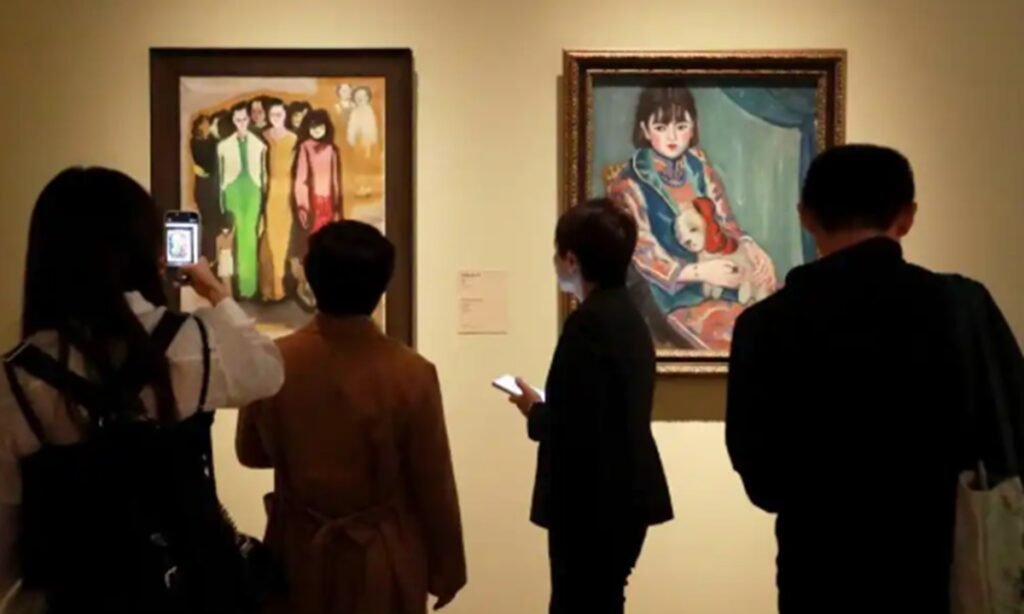It was a pretty wild morning.
In the space of just a few hours, we witnessed a gangland killing, a jewellery heist and stepped onboard a private jet.
We observed a billionaire CEO at work, a dramatic family showdown in a hospital and a drunken karaoke party.
It was all part of a tour around a massive Chinese facility producing what are known as vertical micro-dramas. To describe the experience as somewhat dizzying is an understatement.
If you haven’t heard of them, micro-dramas are a new cultural sensation sweeping not just China but the world, a remarkable example of China’s booming soft power.
They are essentially serialised productions split into episodes of roughly a minute, shot in vertical and viewed solely on smartphones.
Think soap operas for the TikTok generation.
‘Secret surrogate to the Mafia King’
The story lines are sensational and melodramatic with titles that border the ridiculous; ‘Ex-Convict nanny and Billionaire single dad’, ‘Pregnant by my Tough Daddy CEO’ and ‘Secret Surrogate to the Mafia King’, just some examples.

Micro dramas are designed to be watched on smartphones only
The action is fast and the characters simplistic, while autoplay and multiple mini cliff hangers are designed to provide an addictive dopamine hit.
It’s a format which has sprung to life in just the last few years, developed initially in China in the wake of the pandemic, and its success has been extraordinary.
Some of the most-watched titles have hundreds of millions of views and downloads of short drama apps were over six times higher in the first quarter of 2025 than that same period last year, according to data from Sensor Tower, a market intelligence firm.
The Chinese government recently revealed that over 50% of all internet users in China have watched a micro-drama, more than have ordered food online or used a ride-hailing service.
‘You can easily binge five or six episodes on the subway commute’

One of the many set designs in the production factory
“People’s lives are so stressful and packed these days,” explains Ji Jingdong, a producer of micro-dramas who made the switch from traditional film around three years ago.
“When you watch vertical-screen content, you can easily binge five or six episodes on the subway commute, right? And let’s face it, you’re barely halfway through an ordinary TV episode before you reach your stop.
“Scrolling through vertical screens at a fast pace is actually pretty stress-relieving. Especially those so-called ‘mindless dramas’ – they’re incredibly relaxing to watch.”
That mass appeal, paired with extremely fast turnaround times and no-frills production is translating into massive revenues.
Read more from Sky News:
Tel Aviv football derby cancelled after ‘violent riots’
Eight ‘priceless’ objects stolen in Louvre museum heist
Last year, the industry revenue was an astonishing $6.9bn, for the first time exceeding the value of the Chinese box office.
Its figure is almost 14 times as high as in 2021, just three years ago.
But with this huge reach and revenues comes both challenge and opportunity for a system like China where everything including cultural products is strictly controlled.

An actor is filmed for the latest micro-drama
1,200 series taken down
Indeed in February of this year over 1,200 series were taken down, deemed too “vulgar” or inappropriate, while a wave of new regulations now require projects over a certain value to have government approval.
In addition there are initiatives to encourage production houses to make dramas that promote certain values such as ‘Learn the law with Micro-Short Dramas’ and ‘Explore intangible cultural heritage through micro short dramas’.
It’s a framework they are aware of at the Meigao Micro Drama Super Factory, in the southeastern city of Quzhou.
This 67,000 square metre facility was initially constructed as a COVID quarantine hotel, but it now houses around 200 different sets where multiple crews can shoot their dramas simultaneously.
There is almost any indoor environment you could imagine – from a bank, courthouse and subway to a ballroom, office and multiple home environments.
The CEO Dai Wenxue explains with pride how they made 500 micro-dramas last year.
But there is also a clear acknowledgement that the transformation of this venue was achieved with local government support, and that this massive Chinese success story also serves a political purpose.

The industry revenue was $6.9bn last year
Aligning with ‘the nation’s overarching strategic vision’
“The early phase emphasised growth, with the government taking a relatively relaxed but not lax approach,” he explains. “Now, the focus has shifted toward premium production, cultural exports and telling compelling Chinese stories.
“This aligns with the nation’s overarching strategic vision. That’s the current landscape.”
Indeed, while the majority of productions are fun and frivolous, for its critics, the industry is a perfect propaganda tool.
This autumn, in fact, saw a huge boom in government-encouraged patriotic war productions to coincide with the 80th anniversary of the end of World War Two and a huge accompanying military parade in Beijing.
All this mattered because the format is now being aggressively exported abroad.

The Meigao Micro Drama Super Factory in Quzhou
Almost all production houses worth their salt are leaning into English language productions. Meigao is in fact building an entire second location with American-style scenes.
And it’s no wonder when you look at the numbers. According to analysis undertaken by Sensor Tower, in the first quarter of 2025, downloads in the US had gone up 54% compared to the same period in 2024. In Latin America it was 69% and in India a remarkable 113%.
‘A huge uptick’
“So in the past 10 months, right after the Chinese New Year, there was definitely a huge uptick,” says Max Olsen, an American actor living in Beijing. For him and other Western actors there has been a hugely noticeable boom in work .
“A bunch of productions decided that they were going to shoot, you know, they’re going to produce one a week.
“Obviously, with money, with eyeballs, with attention, comes a degree of power.”
Please use Chrome browser for a more accessible video player

1:58
Three things you may have missed from China this week
There are of course questions about how this type of soft power translates and what China could or would do with it. But it is just one of a number of cultural exports playing into a trend of China positioning itself as accessible and relatable, even ‘cool’.
Indeed for such a new format there is clearly still results yet to be seen.
“I don’t think the double-digit growth will continue forever,” says Olsen.
“But I suspect in five years’ time, we’ll have a very established industry.”






